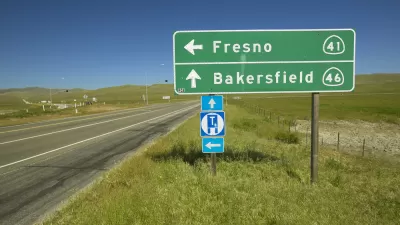The California Legislature took steps to address the state's housing crisis this year, but housing activists might look to the Governor's High Speed Rail project to provide a link to affordable housing in the Central Valley.
The political messaging of the California High Speed Rail over the past decade has been focusing on the notion of connecting Northern California to Southern California, eliminating those long drives on the Interstate 5 or 101 Freeway. Now, in an interview with The Planning Report, California High-Speed Rail Authority Board Chair Dan Richard reframing the value of CA HSR as one solution to the significant state housing crisis.
As the CA HSR Authority seeks a new CEO to guide the program’s next phase, Richard spoke about the fact that the entire program is at a crossroads. Politically unpopular and still needing a huge amount of investment to be financed to completion, the high-speed rail project is also currently successfully laying track and creating jobs in the Central Valley.
In the interview, Richard spoke about the role of high-speed rail to allow Silicon Valley to continue to flourish by relieving some of the housing pressure. As the first leg of the project will connect the Central Valley to San Jose, Richard spoke of the state's goal is to place transit-oriented development and housing investments into cities like Fresno and Madera that will have stops along the route. The families living in those communities will be able to get to the jobs hub of San Jose in under 90 minutes.
Developing in the Central Valley is less than half of the cost to develop in San Francisco, according to Gov. Jerry Brown's budget summary for 2017-18. In building where local governments are actively pushing for development and revitalization, the rail project seeks to boost the local, regional, and even national economy.
"[The first leg] will open up freight rail capacity for ports that see 40 percent of America’s imports. And because of the Build American provision, we’re on the cusp of encouraging a whole new manufacturing sector around high-speed trade. The federal government should continue to be a full partner in this effort, particularly when California is stepping forward with more than $20 billion of state investment...In Fresno, one of the poorest counties in the United States—with a poverty rate in excess of 25 percent— the unemployment rate has fallen below 10 percent for only the fourth time in the last 25 years. Academic studies are pointing to high-speed rail investment as the main reason for that. We’re also working with the city of Fresno on development plans around their station. The word that comes to mind is “transformative”: I think this investment is going to transform Fresno and other Central Valley cities that have been hollowed out over the years."
Dealing with the financing is still a looming challenge. When asked about the future, Richard pointed to the recent action by the California Legislature to extend the cap-and-trade program for 10 years as major boost to the HSR Authority's ability to finance. He opined on the situation, saying:
"The bedrock of financing is certainty. Whether you’re a business, a government, or whatever, if you’re going to ask other people to loan you money, you’ve got to provide them with a sense of stability in terms of repayment. Once we have that, we’ll be able to tap into a number of financing programs, both public and private."
Read more in The Planning Report.
FULL STORY: CA High-Speed Rail Chair on the 'Transformative' Impacts of 'Connecting' California

Trump Administration Could Effectively End Housing Voucher Program
Federal officials are eyeing major cuts to the Section 8 program that helps millions of low-income households pay rent.

Planetizen Federal Action Tracker
A weekly monitor of how Trump’s orders and actions are impacting planners and planning in America.

Ken Jennings Launches Transit Web Series
The Jeopardy champ wants you to ride public transit.

When Borders Blur: Regional Collaboration in Action
As regional challenges outgrow city boundaries, “When Borders Blur” explores how cross-jurisdictional collaboration can drive smarter, more resilient urban planning, sharing real-world lessons from thriving partnerships across North America.

Philadelphia Is Expanding its Network of Roundabouts
Roundabouts are widely shown to decrease traffic speed, reduce congestion, and improve efficiency.

Why Bike Lanes Are Good: An Explainer for the US Transportation Secretary
Sean Duffy says there’s no evidence that bike lanes have benefits. Streetsblog — and federal agencies’ own data — beg to differ.
Urban Design for Planners 1: Software Tools
This six-course series explores essential urban design concepts using open source software and equips planners with the tools they need to participate fully in the urban design process.
Planning for Universal Design
Learn the tools for implementing Universal Design in planning regulations.
Ada County Highway District
Clanton & Associates, Inc.
Jessamine County Fiscal Court
Institute for Housing and Urban Development Studies (IHS)
City of Grandview
Harvard GSD Executive Education
Toledo-Lucas County Plan Commissions
Salt Lake City
NYU Wagner Graduate School of Public Service



























